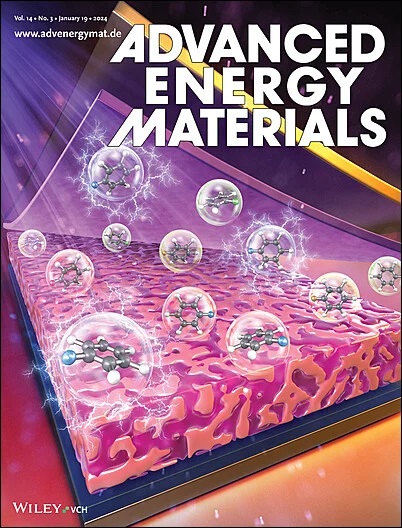Gyro‐Multigrid Triboelectric Nanogenerator via Topological Defects Strategy for Efficiently Harvesting Low‐Grade Wave Energy
IF 24.4
1区 材料科学
Q1 CHEMISTRY, PHYSICAL
引用次数: 0
Abstract
Wave energy is a promising sustainable energy yet to be fully exploited due to the low frequency and broad‐banded wave fields, so much so that difficult to capture, resulting in low efficiency and limited power output from current many wave energy harvesters. Here, a topological defect gyro‐multigrid triboelectric nanogenerator (TD‐GM‐TENG) is proposed that harnesses the mechanical energy of ocean waves to generate electricity and promotes the accumulation of triboelectric charge on the basis of realized from low to high rotation speed under the precession and gravitation acceleration effects. It benefited from topological defect strategy, TD‐GM‐TENG offers a charge transfer rate of 3.1 µC s基于拓扑缺陷策略的陀螺-多网格摩擦纳米发电机高效收集低阶波能
波浪能是一种很有前途的可持续能源,但由于其低频和宽带状波场,难以捕获,导致目前许多波浪能采集器效率低,输出功率有限。本文提出了一种拓扑缺陷陀螺-多栅格摩擦电纳米发电机(TD - GM - TENG),该发电机利用海浪的机械能发电,并在进动和重力加速度作用下实现从低速到高速的旋转,促进摩擦电荷的积累。得益于拓扑缺陷策略,TD - GM - TENG提供了3.1 μ C s−1的电荷传输速率,当波频率为1 Hz时,可以达到接近1000 rpm的速度。此外,在0.06 s的循环周期内,电荷密度达到90µC m−2,是海洋能源收集领域同类球形teng的1.6倍。最后,TD‐GM‐TENG装置在1 Hz模拟水波环境下输出峰值功率3.7 mW,验证了其在海上观测预警服务中作为分布式应急电源的适用性和可行性。
本文章由计算机程序翻译,如有差异,请以英文原文为准。
求助全文
约1分钟内获得全文
求助全文
来源期刊

Advanced Energy Materials
CHEMISTRY, PHYSICAL-ENERGY & FUELS
CiteScore
41.90
自引率
4.00%
发文量
889
审稿时长
1.4 months
期刊介绍:
Established in 2011, Advanced Energy Materials is an international, interdisciplinary, English-language journal that focuses on materials used in energy harvesting, conversion, and storage. It is regarded as a top-quality journal alongside Advanced Materials, Advanced Functional Materials, and Small.
With a 2022 Impact Factor of 27.8, Advanced Energy Materials is considered a prime source for the best energy-related research. The journal covers a wide range of topics in energy-related research, including organic and inorganic photovoltaics, batteries and supercapacitors, fuel cells, hydrogen generation and storage, thermoelectrics, water splitting and photocatalysis, solar fuels and thermosolar power, magnetocalorics, and piezoelectronics.
The readership of Advanced Energy Materials includes materials scientists, chemists, physicists, and engineers in both academia and industry. The journal is indexed in various databases and collections, such as Advanced Technologies & Aerospace Database, FIZ Karlsruhe, INSPEC (IET), Science Citation Index Expanded, Technology Collection, and Web of Science, among others.
 求助内容:
求助内容: 应助结果提醒方式:
应助结果提醒方式:


